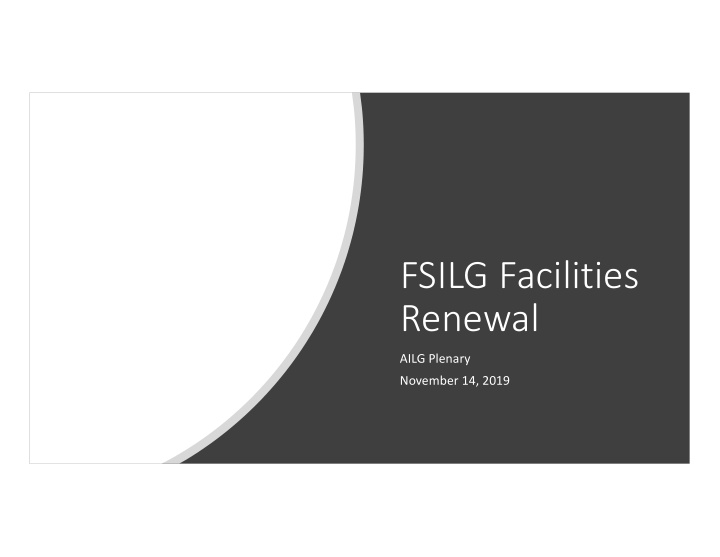



FSILG Facilities Renewal AILG Plenary November 14, 2019
FS FSILG Facilities Renewal Overview • Goal: to promote and support implementation of the physical renewal of MIT’s FSILG residences. • 2018-present - FSILG Facilities Renewal Committee: Formed to facilitate improvements by implementing the recommendations of the facilities assessments. • Focusing on community-wide life safety system upgrades.
FS FSILG Life-Sa Safety Improvement Program Concept PHASE 1 (2019-20) PHASE 2 (2020-22) PHASE 3 (2022-28) Conceptual Project Repair/replace egress Upgrade fire Upgrade sprinkler Scope doors and hardware alarms systems Proposed IRDF IRDF IRDF Funding <$700K <$3M ~$5M Estimated Average $17K/house ~$90K/house >$100K/house; Cost Range $0-$30K ~ 6 with new systems Several with new systems Project manager Project manager Project manager Proposed overseen by FSILG overseen by FSILG overseen by FSILG Project Facilities Renewal Facilities Renewal Facilities Renewal Management Committee Committee Committee 2019-2028
AI AILG Facilities Renewal Survey
IR IRDF Update AILG Plenary November 14, 2019
IR IRDF: His istory ~ Founded in 1964 by MIT alumni ~ The IRDF is a special MIT fund offering targeted grants and low-interest loans to help FSILGs improve their residences, make them accessible to students with disabilities, and enhance the safety and educational spaces of their residences.
IR IRDF: Evolv lvin ing Over Tim ime IRDF programs have evolved to meet the needs of the community – the IRDF started as a loan program and added a grant program in 1997. New programs for 2019 • Addition of historic preservation as an eligible expense • Micro-loans • Use of IRDF for capital campaigns
IR IRDF: Governance • Board of Allocation Dave Latham ‘61, Steve Stuntz ‘67, and Susan Woodmansee ’97 • Grant Advisory Board Pamela Gannon ‘84, Tom Holtey ‘62, and Sara Wilmer ’03 • Architectural Review Board - NEW Steve Baker ‘84, Ilkka Suvanto ‘68, Barbara Thornton ’80 • Support is provided by Kevin Milligan of the MIT Finance Office, Pamela Gannon ‘84 of the Division of Student Life, and Scott Klemm of the FSILG Cooperative, Inc.
IR IRDF: Overvie iew Investment Income Interest Alumni on IRDF Donations loans Educational IRDF Operating Low Interest Grants Loans ** A nnual reimbursement for educational space Minor Project Major Project Grants * Grants * < $100K > $100K Limited annual funds Dependent on alumni No giving requirement giving to specific chapter * Eligible expenses ** IRDF loans: for IRDF grant reimbursement: FSILG House 1. Long term, low interest, >$100K 1. Safety improvements (typically 30 years, 3% interest) 2. Accessibility improvements 2. New “micro-loan” program 3. Educational space & equipment 4. Historic preservation
IR IRDF: Programs 1. Low Interest Loans • No giving requirement • Micro-loan program (<$100,000) - NEW 2. Educational Operating Grants (EOGs) => ~$450,000 total annually • Each FSILG applies and receives annually • For operating expenses related to educational space 3. Minor Project Grants ( ~$200,000 total annually) => Reimbursement • No giving requirement • Allocated annually, FSILG must apply, limited funds available 4. Major Project Grants (>$100,000 each) => Reimbursement • Giving requirement – for capital campaigns • Organization’s capital campaign directs contributions to IRDF (90/10 split - NEW) 5. Community-Wide Programs • To implement system-wide upgrades and improvements
Wh What Can the IRDF Provide Reimbursement For? The IRDF can provide reimbursement through grants for: • Educational equipment • Safety improvements • Accessibility • Historic preservation - NEW! We want you to improve your houses and apply for project grants and loans!
IR IRDF: FY2019 (Ju July ly 1, 2018-Ju June 30, 2019) ) • Donations to the IRDF $780,000 total gifts: $400,000 considered “unrestricted” 870 total gifts Range $5 - $100,000; Median $100 • Donors Alums, students, spouses, parents, friends, matching funds Members of every FSILG • Highlights Youngest donors: Hilary Vogelbaum ’20 AXO, Matthew Tung ’20 PLP, Michael Trinh ’19 ZP Oldest donor: William G Denhard '42 PKS, Clinton Springer ‘45 (deceased) Largest # of donors: DTD 46, PKS 44, PSK 40 Most $ donated (no capital campaign): KS, PBE
IR IRDF: 2019 MIT IT 24-Ho Hour Challenge • Raised $49,284 for the IRDF • $24,284 was the result of 215 gifts from generous alums, students, friends and families • $25,000 in matching funds from the 484 Foundation, the alumni foundation of Sigma Alpha Epsilon
Wh Where to find more information? • IRDF web site: http://web.mit.edu/irdf/ • IRDF FAQs – developed this year • Contact Scott Klemm, FCI Executive Director, sklemm@fsilg.coop Pam Gannon, Director of FSILG Alumni Programs, pmgannon@mit.edu
IR IRDF: : Sustainability ty and Planning for r th the Futu ture • Value of the fund: $20,000,000 $15,000,000 out in loans; $20,000,000 given out in grants 1997-2020 Some funds committed to particular organizations (capital campaigns) Allocation for EOGs and minor project grants • Major source of income for the IRDF is alum donations and interest on IRDF loans • We are working with MIT Resource Development and the Annual Fund to encourage more donations to the IRDF • 90/10 split could incentivize donations for major project grants BUT “unrestricted” donations to the community fund are essential for the health of the FSILG community overall • Survey – please respond!
Recommend
More recommend